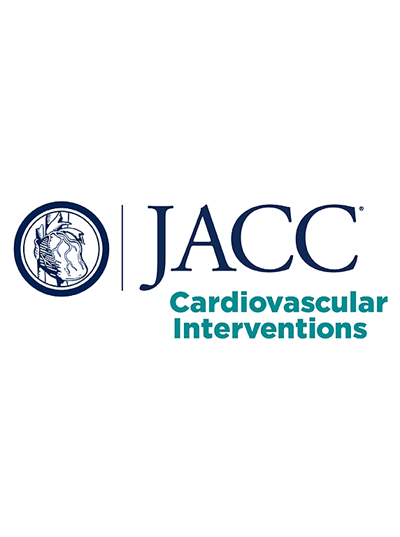Validation of Intravascular Ultrasound–Defined Optimal Stent Expansion Criteria for Favorable 1-Year Clinical Outcomes
IF 11.4
1区 医学
Q1 CARDIAC & CARDIOVASCULAR SYSTEMS
引用次数: 0
Abstract
Background
Robust evidence on optimal stent expansion using intravascular ultrasound (IVUS) is still lacking.
Objectives
The aim of this study was to validate the impact of different criteria for IVUS-defined optimal stent expansion on 1-year clinical outcomes after percutaneous coronary intervention (PCI).
Methods
Individual patient data from 3 randomized trials were aggregated for this analysis. Patients (n = 6,290) were classified into 3 groups: optimized PCI by IVUS, nonoptimized PCI by IVUS, and angiography-guided PCI. The primary endpoint was target vessel failure (TVF) at 1 year, a composite of cardiac death, target vessel myocardial infarction, or target vessel revascularization.
Results
Angiography-guided PCI was performed in 3,208 patients. Optimal stent expansion was evaluated in 3,082 patients with IVUS-guided PCI. For the absolute criterion of minimal stent area (MSA) >5.5 mm2 indicating optimal stent expansion, the optimized PCI group had a lower incidence of TVF (1.45% vs 3.86% vs 5.07%) compared with the nonoptimized PCI group (adjusted HR: 0.45; 95% CI: 0.26-0.75; P = 0.002) and the angiography-guided PCI group (adjusted HR: 0.35; 95% CI: 0.22-0.54; P < 0.001). Relative criteria did not show a significantly different TVF incidence between the optimized and nonoptimized PCI groups. In particular, the absolute criterion of MSA >5.5 mm2 was associated with a significant reduction of the composite of cardiac death or target vessel myocardial infarction (0.54% in the optimized PCI group vs 1.59% in the nonoptimized PCI group; adjusted HR: 0.39; 95% CI: 0.17-0.91; P = 0.028).
Conclusions
Post-PCI stent expansion meeting an absolute criterion of MSA >5.5 mm2 was associated with the most favorable clinical outcomes. (Effect of Intravascular Ultrasound in Patients Receiving Percutaneous Coronary Intervention With New-Generation Drug-Eluting Stents: An Individual Patient Data Meta-Analysis of IVUS-XPL, ULTIMATE and IVUS-ACS Randomized Trials; CRD42024559794)
血管内超声定义的最佳支架扩张标准对1年良好临床结果的验证
背景:目前仍缺乏血管内超声(IVUS)进行最佳支架扩张的有力证据。目的本研究的目的是验证ivus定义的最佳支架扩张的不同标准对经皮冠状动脉介入治疗(PCI)后1年临床结果的影响。方法收集来自3个随机试验的个体患者数据进行分析。6290例患者分为IVUS优化PCI、IVUS非优化PCI和血管造影引导下PCI 3组。主要终点是1年时靶血管衰竭(TVF)、心源性死亡、靶血管心肌梗死或靶血管重建术的综合结果。结果3208例患者行血管造影引导下PCI。对3082例ivus引导下PCI患者进行最佳支架扩张评估。对于最小支架面积(MSA) >;5.5 mm2表示最佳支架扩张的绝对标准,优化PCI组的TVF发生率(1.45% vs 3.86% vs 5.07%)低于未优化PCI组(调整HR: 0.45; 95% CI: 0.26-0.75; P = 0.002)和血管造影引导下PCI组(调整HR: 0.35; 95% CI: 0.22-0.54; P < 0.001)。相对标准未显示优化和非优化PCI组间TVF发生率有显著差异。特别是,MSA >;5.5 mm2的绝对标准与心源性死亡或靶血管心肌梗死的复合发生率显著降低相关(优化PCI组为0.54%,非优化PCI组为1.59%;调整HR: 0.39; 95% CI: 0.17-0.91; P = 0.028)。结论pci后支架扩张达到MSA >;5.5 mm2的绝对标准是最有利的临床结果。(血管内超声对新一代药物洗脱支架经皮冠状动脉介入治疗患者的影响:IVUS-XPL、ULTIMATE和IVUS-ACS随机试验的个体患者数据荟萃分析;CRD42024559794)
本文章由计算机程序翻译,如有差异,请以英文原文为准。
求助全文
约1分钟内获得全文
求助全文
来源期刊

JACC. Cardiovascular interventions
CARDIAC & CARDIOVASCULAR SYSTEMS-
CiteScore
11.60
自引率
8.80%
发文量
756
审稿时长
4-8 weeks
期刊介绍:
JACC: Cardiovascular Interventions is a specialist journal launched by the Journal of the American College of Cardiology (JACC). It covers the entire field of interventional cardiovascular medicine, including cardiac, peripheral, and cerebrovascular interventions. The journal publishes studies that will impact the practice of interventional cardiovascular medicine, including clinical trials, experimental studies, and in-depth discussions by respected experts. To enhance visual understanding, the journal is published both in print and electronically, utilizing the latest technologies.
 求助内容:
求助内容: 应助结果提醒方式:
应助结果提醒方式:


